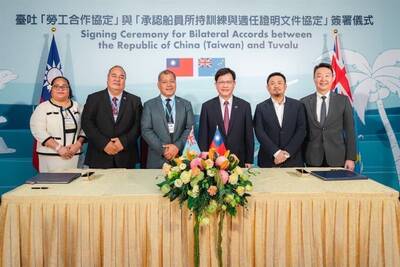The Tea Research and Extension Station is next month to establish a “beverage center” to develop new methods for creating tea-based mixed drinks in response to the expanding popularity of the hand-shaken beverage industry.
“Hopefully, technical investment from the government can help the private sector further develop the market to form a ‘national tea team,’” Council of Agriculture Minister Chen Chi-chung (陳吉仲) said on Saturday of the new center.
Taiwan’s tea-based beverage industry is renowned worldwide, providing a valuable and growing export market for farmers.

Photo: Chang Chia-ming, Taipei Times
In the first 10 months of this year, exports of tea and related products rose 30 percent year-on-year, Ministry of Economic Affairs data show.
Drink stores comprise a significant industry, with sales exceeding NT$58 billion (US$2.09 billion) last year, an 80 percent rise over the past decade.
About 1.02 billion hand-shaken drinks are sold every year in Taiwan, working out to at least 43 cups per person or one every week.

Photo: Bloomberg
Taiwanese tea drinks have changed dramatically over the years, station director Su Tsung-chen (蘇宗振) said.
“It used to be a tea culture, but now it is a tea drink culture,” he said.
To meet demand from an increasing number of tea shops and younger tea drinkers, the station decided to create the beverage center to further expand the growing industry, Su said.
The center would have five to seven people collaborating with private operators to develop drinks using local crops, he said.
As tea is the base for all of the beverages, the center is to research tea blending techniques along with the best ratios for pairing additives such as alcohol or fruit juice, Su said.
The station’s ginger black tea is a prime example, he said.
Ginger must be boiled for a long time to release its flavor, but if tea leaves are boiled along with it, the drink becomes bitter and astringent, he said.
The station therefore pairs ground dried ginger with tea, so the two flavors are extracted at the same rate when it is steeped, he added.
The center would also look at other beverage crops such as coffee, cocoa, mint and chrysanthemum, as well as toppings such as fruit, tapioca pearls and jellies, Su said.
“This is because tea drinks use many mix-and-match ingredients,” he added.
Anything that can be used in a drink would be considered, Su said, adding that the station has developed a method of turning fruit into fine powder.
Apart from its use as a natural coloring or baking ingredient, the powder can also be added to tea to create fruit drinks, he said.

The Ministry of Economic Affairs has fined Taobao NT$1.2 million (US$36,912) for advertisements that exceed its approved business scope, requiring the Chinese e-commerce platform to make corrections in the first half of this year or its license may be revoked. Lawmakers have called for stricter enforcement of Chinese e-commerce platforms and measures to prevent China from laundering its goods through Taiwan in response to US President Donald Trump’s heavy tariffs on China. The Legislative Yuan’s Finance Committee met today to discuss policies to prevent China from dumping goods in Taiwan, inviting government agencies to report. Democratic Progressive Party Legislator Kuo Kuo-wen (郭國文) said

The Ministry of Economic Affairs has fined Taobao NT$1.2 million (US$36,900) for advertisements that exceeded its approved business scope and ordered the Chinese e-commerce platform to make corrections in the first half of this year or its license would be revoked. Lawmakers have called for stricter supervision of Chinese e-commerce platforms and more stringent measures to prevent China from laundering its goods through Taiwan as US President Donald Trump’s administration cracks down on origin laundering. The legislature’s Finance Committee yesterday met to discuss policies to prevent China from dumping goods in Taiwan, inviting government agencies to report on the matter. Democratic Progressive Party

Taiwan and its Pacific ally Tuvalu on Tuesday signed two accords aimed at facilitating bilateral cooperation on labor affairs, according to Taiwan’s Ministry of Foreign Affairs (MOFA). The governments inked two agreements in Taipei, witnessed by Foreign Minister Lin Chia-lung (林佳龍) and visiting Deputy Tuvaluan Prime Minister Panapasi Nelesone, MOFA said in a news release. According to MOFA, the agreements will facilitate cooperation on labor issues and allow the two sides to mutually recognize seafarers’ certificates and related training. Taiwan would also continue to collaborate with Tuvalu across various fields to promote economic prosperity as well as the well-being of their

Sung Chien-liang (宋建樑), who led efforts to recall Democratic Progressive Party (DPP) Legislator Lee Kun-cheng (李坤城), was released on bail of NT$80,000 today amid outcry over his decision to wear a Nazi armband to questioning the night before. Sung arrived at the New Taipei District Prosecutors’ Office for questioning in a recall petition forgery case last night wearing a red armband bearing a swastika, carrying a copy of Adolf Hitler’s Mein Kampf and giving a Nazi salute. Sung left the building at 1:15am without the armband and covering the book with his coat. Lee said today that this is a serious